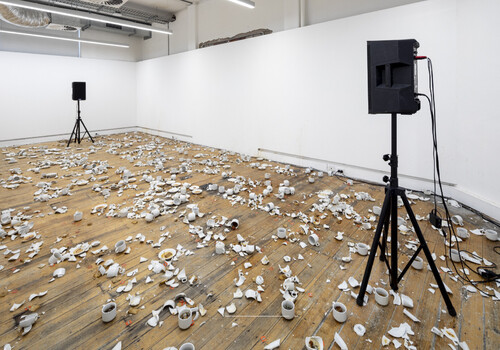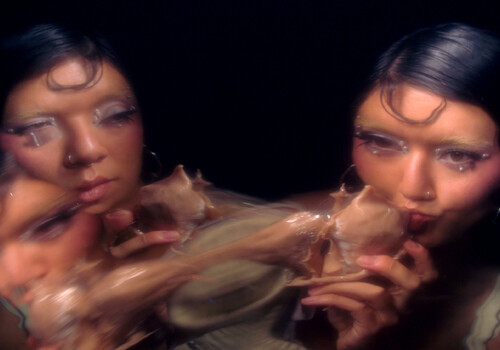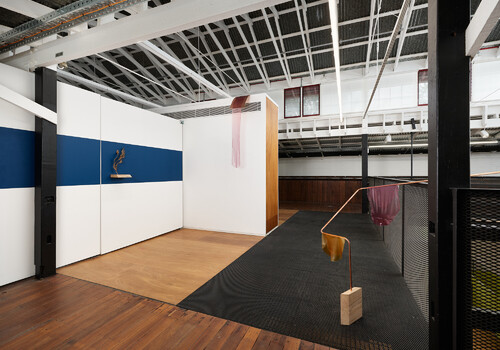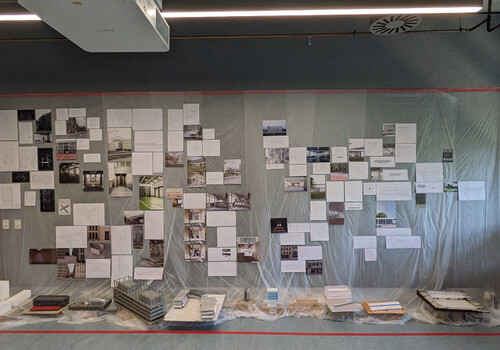Jewellery and Glass, Sydney College of the Arts
By Victoria Gillespie
I’m at the Sydney College of the Arts grad show opening and it’s a melée of nostalgia. Graduates and the carousing crowds are adorned in 90s-era indie sleaze and raggedy UTS-fashion garments. This is a celebration of cigarette-smoking, FM-listening artists who are obsessed with the analogue. Outside, a protest against SCA’s ties to an Israeli institution brings loud chants and a security phalanx, and a call to confront our present. Inside, however, the artworks summon me back to the past.
Many of the artists test the waters of temporality: Are we existing in the present or the past, or some space, confusingly, in-between? Some, like Lukas Kalos, parse the past with the analogue material of CD cases. Tahlia Curnow offers a Grimms-esque storybook, accompanied by gothic, Victorian-era illustrations. Jazmin Bryant recreates old family photographs. Jack Wotton looks back on the Black Summer bushfires of 2019/2020, and Carol Arpas employs the pre-cinematic technology of the zoetrope to critique capitalist alienation. However well executed, the historical techniques and sentimental subject-matter strip the show of urgency.
SCA’s building, the post-WWI era Old Teachers’ College, similarly wears its past on its sleeve. The building’s patina––wood paneling, discontinuous signage, and display vitrines––reveal a long educational history. No wonder the cohort is trying to understand themselves through the archives.

Installation view of Steph Bouris, (do you ever feel) Like A Plastic Bag, 2024, Hand-blown Glass, Sydney College of the Arts, University of Sydney, Sydney. https://new-contemporaries-sca.sydney.edu.au/2024/students/steph-bouris. Photo: Document Photography.
The glass and jewellery disciplines typify this. In the initial ground-level rooms, I encounter Steph Bouris’ (do you ever feel) Like A Plastic Bag (2024). It is a triptych of sorts. Three glass figures float above a disfigured trolley. I am told to use my own light; always servile to the Great Wall Label, I obey. The glass figures reveal themselves as forlorn bags from Franklin’s, a supermarket forgotten by our ever-price-gouging duopolistic present. I don’t believe Bouris is trying to talk about evil supermarkets, but that’s all I can think about. The Katy Perry allusion points viewers down a 2010s, galaxy-print peplum memory-lane instead. It’s fun and uncanny.

Installation view of Evangeline McGowan Braithwaite, Imbument, 2024, varied, found and created objects, Sydney College of the Arts, University of Sydney, Sydney. https://new-contemporaries-sca.sydney.edu.au/2024/students/evangeline-mcgowan-braithwaite. Photo: Document Photography.
Wandering lost in the OTC’s vexing floor-plan, I encounter Evangeline McGowan Braithwaite’s Imbument (2024). The piece overwhelms Room 217A with a collection of found and made objects. The star pieces, engraved metal jewellery modelled on vintage pieces, hide amongst miscellanea like letters, toys and children’s art. Braithwaite wants to transform the space into an antique store. But with its clutter, soft lighting, and sheets, it feels more like a childhood bedroom. As SCA’s graduates face life beyond tertiary education, the return home seems tempting (or perhaps inevitable).

Installation view of Sienna Woodburn, Familiarity, 2024, glass, Sydney College of the Arts, University of Sydney, Sydney. https://new-contemporaries-sca.sydney.edu.au/2024/students/sienna-woodburn. Photo: Document Photography.
In another room, Sienna Woodburn’s mnemonic stained-glass panels catch the light. With this meaning-laden material, Familiarity (2024) recalls church windows and inner-west terraces. Woodburn’s own “forgettable memories” are forever forged by a rough alloying of colourful glass. The composition––a few panels perched on a triangular plinth while another three hang above––extends the religious analogy. Am I to pray at the altar of sentimentality?
In her opening remarks, SCA’s co-director Julie Rrap said it was the best show the building had seen. No one seemed to be listening, fanning themselves with the room sheets and protest pamphlets. I, however, took Rrap at her word (she knows what she’s talking about), and looked closely—and found a cohort obsessed with the past. Sure, nostalgia is useful, and its art can offer reprieve from an urgent world. But can we really trade in this sentimentality and find ourselves in the past, if activists are protesting, now, outside? The show is so focused on the past that it seems to have forgotten about the present. Am I wrong to expect agitation and antagonism from the aesthetes?
Victoria Gillespie is an Honours student at the University of Sydney, studying the visual archive of activism and protest.









































